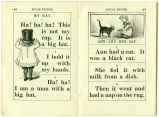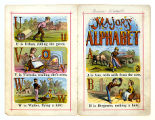It took some time but thanks to Mrs. Barbauld and other sensible teachers, the formula for ideal early reading material, though simple, was finally perfected: relatively small books, wide margins, large type, colored pictures, interesting content, nothing religious or moral, a little humor.
 |
THE VICTORIA PRIMER, OR FIRST BOOK FOR CHILDREN. York [England]: printed and sold by James Kendrew, [1840].
Chapbook with woodcut illustrations, uncolored. Exhibit checklist 6.1 (View this item) |
 |
LESSONS FOR INFANT SCHOOLS. Philadelphia: American Sunday School Union, [ca. 1845].
Woodcut illustrations, uncolored. The subject matter of this early reader is common. The early schools were often taught by the community leader; i.e. the church minister or his wife. Text includes: "In the fear of the Lord is the beginning of wisdom; If sinners entice thee, consent thou not; and The wages of sin is death."
The American Sunday School Union was founded in 1817, an interdenominational organization. It began to create literature for children. The books were written anonymously and required approval by a committee made up of at least three members from different denominations. Sunday School libraries stocked with ASSU publications were the earliest free children's circulating libraries. Exhibit checklist 6.2 (View this item) |
 |
THE NEW ENGLAND PRIMER. Boston: Massachusetts Sabbath School Society, 1843.
Chapbook with woodcut illustrations, uncolored. The NEW ENGLAND PRIMER was rigidly formulaic. This oft-reprinted religious primer is the subject of many bibliographies. Hundreds of editions are known to have been printed, perhaps as many as there were printing presses in colonial America. The book was dubbed "The Little Bible." The alphabet is illustrated. Exhibit checklist 6.5 (View this item) |
 |
FACTS AND STORY READERS: PRIMER. By Henry Suzzallo, George E. Freeland, Katherine L. McLaughlin, Ada M. Skinner; illustrated by Ruth M. Hallock et al. New York and Cincinnati: American Book Company, ©1930 and later.
Relief illustrations, color printed, called color chromoxylographs. Henry Suzzallo was president of the University of Washington from 1915-1926; one of the main library buildings is named after him. After he was fired, he served as director of the National Advisory Committee on Education and president of the Carnegie Foundation for the Advancement of Teaching. When this series was published, he was a visiting professor of education at Columbia University in NYC where he had gotten his graduate degree.
Suzzallo, a major and controversial force in regional labor issues, was removed from his UW position by Governor Ronald H. Hartley who felt that Suzzallo's influence had created a socialist environment on campus. The real radicals of the time, including Anna Louise Strong, considered him anything but.
In the book, little girls make hats for their dolls while the boys build chairs for the dollhouse. This copy is from Suzzallo's own collection. Exhibit checklist 6.6 (View this item) |
 |
THE NEW ENGLAND PRIMER IMPROVED, OR AN EASY AND PLEASANT GUIDE FOR CHILDREN TO THE ART OF READING TO WHICH IS ANNEXED, THE SHORTER CATECHISM. Concord, N.H.: Printed by George Hough, 1828.
Chapbook with woodcut illustrations, uncolored. This is the second edition of this title by this printer; the first was 1823. Exhibit checklist 6.7 (View this item) |
 |
THE SILVER PRIMER, OR, FIRST BOOK FOR CHILDREN. York (England): Printed and sold by James Kendrew, [1815-1841?].
Chapbook with woodcut illustrations, uncolored. Exhibit checklist 6.8 (View this item) |
 |
Advertising card for Niagara Starch showing a young girl reading, ca. 1887.
Relief illustration, color printed. Exhibit checklist 6.9 (View this item) |
 |
THE NEW ROYAL PRIMER: PART II, THE LONG VOWEL SOUNDS. London & Edinburgh: T. Nelson and Sons, [1880?].
Chapbook with woodcut illustrations, uncolored. Exhibit checklist 6.10 (View this item) |
|
McGUFFEY READERS by William Holmes McGuffey (1800-1873).
McGuffey was born and raised in the Ohio River valley, graduated from
Washington and Jefferson College in Pennsylvania and taught at Miami University (Oxford, OH) before accepting the presidency of several area colleges. He was better at teaching than administering and ultimately landed at the University of Virginia where he enjoyed success as a scholar and teacher. In 1836 McGuffey contracted with Truman and Smith to create a series of readers. As of 1961, it is estimated that over 122 million copies had been sold. According to publisher Smith, McGuffey's books were "adapted to the habits, energy, and ideals of the frontier people of the West." Their success relied on careful selection of material, vocabularies and concepts that were challenging and solid morality lessons. |
 |
MCGUFFEY'S NEWLY REVISED ECLECTIC THIRD READER,
CONTAINING SELECTIONS IN PROSE AND POETRY WITH RULES FOR READING; EXERCISES IN ARTICULATION, DEFINING, ETC. BY Wm. H. McGuffey. Revised Stereotyped Ed. NY: Clark, Austin Smith; Cincinnati: W. B. Smith & Co., [1853]. Exhibit checklist 6.11 (View this item) |
 |
MCGUFFEY'S NEW FIRST ECLECTIC READER: FOR YOUNG
LEARNERS. By Wm. H. McGuffey. New York, Cincinnati, Chicago: American Book Company, [1885]. Exhibit checklist 6.12 (View this item) |
 |
THE NEW MCGUFFEY READERS, SERIES FIRST-FIFTH. 1901.
Exhibit checklist 6.13 (View this item) |
 |
THE ILLUSTRATED PRIMER; OR THE FIRST BOOK FOR CHILDREN: DESIGNED FOR HOME OR PARENTAL INSTRUCTION. New York: George F. Cooledge & Brother, [1844-1871].
Chapbook with woodcut illustrations, uncolored. Some illustrations signed by Alexander Anderson. Exhibit checklist 6.16 (View this item) |
 |
THE GOLDEN PRIMER. By J. M. D. Meiklejohn with illustrations by Walter Crane. London & Edinburgh: William Blackwood & Sons, [1884]. Engraved and printed by Edmund Evans.
Wood engraved illustrations, color printed. Dr. Meiklejohn was Professor of the Theory, History and Practice of Education in the University of St. Andrews, Scotland. Exhibit checklist 6.17 (View this item) |
 |
FUN WITH DICK AND JANE. By William S. Gray and May Hill Arbuthnot. Illustrated by Eleanor Campbell and Keith Ward. Chicago: Scott, Foresman and Company, 1940.
This first reader incorporates the 58 words from the three pre-primers and adds 100 more words. "Baby" is now "Sally." This new edition was first offered on a trial basis to first graders at certain schools beginning September 1939. Exhibit checklist 6.18 (View this item) |
 |
THINK-AND-DO BOOK. By William S. Gray and Marion Monroe. Chicago: Scott, Foresman and Company, 1940.
Created to accompany the pre-primers in the Dick and Jane series. Exhibit checklist 6.19 (View this item) |
 |
NATIONAL PICTORIAL PRIMER OR THE FIRST BOOK FOR CHILDREN DESIGNED FOR HOME OR PARENTAL INSTRUCTION. New York: George F. Cooledge & Brother, 1850.
Wood engraved illustrations, uncolored. Gift of E. G. Ames. Exhibit checklist L.24 (View this item) |
 |
MAJOR'S ALPHABET. New York: McLoughlin Brothers, [1870-1879].
Relief illustrations, color printed. Exhibit checklist L.29 (View this item) |
 |
COBWEBS TO CATCH FLIES; OR DIALOGUES IN SHORT SENTENCES...IN TWO VOLUMES. VOL. I CONTAINING, EASY LESSONS IN WORDS OF THREE LETTERS, FOUR LETTERS...SUITED TO CHILDREN FROM THREE TO FIVE YEARS OF AGE. By Lady Eleanor Fenn. London: Printed for Baldwin, Cradock and Joy, 1825.
Woodcut illustrations, uncolored. First published by John Marshall ca. 1783, the author addresses her readers: "My Dears, Do not imagine that, like a great spider, I will give you a hard gripe, and infuse venom to blow you up. No; I mean to catch you gently, whisper in your ears." Written in dialogues this popular reader was in print throughout the 19th century. Exhibit checklist L.31 (View this item) |
 |
THE PICTURE ALPHABET FOR A GOOD CHILD. No publication information.
Woodcut illustrations, hand colored. Printed paper circles with letters on one side and images on the other, some with multiple letters. Enclosed in an original circular wooden box with printed paper label on lid. Exhibit checklist L.34 (View this item) |
 |
LITTLE LEARNER'S ABC PICTURE BOOK. London: Religious Tract Society, [ca. 1841].
Relief illustrations, color printed by Kronheim & Co. Exhibit checklist L.35 (View this item) |
 |
THE ECLECTIC PRIMER; FOR YOUNG CHILDREN DESIGNED TO PRECEDE W. H.
M'GUFFEY'S ECLECTIC READERS. Cincinnati: Truman and Smith, [c. 1837].
Fourteenth edition.
Chapbook with woodcut illustrations, uncolored. Lesson XIII
reads, "The Sick Lit-tle Girl", which ends, "You may be sick, and I may be
sick. We may all be sick and soon have to die." Exhibit checklist 11.10 (View this item)
|
 |
LESSONS FOR CHILDREN. By Mistress Barbauld. London: Baldwin, 1815. Printed by T. Bensley. Vol. 1 and 2.
Mrs. Anna Laetitia (Aikin) Barbauld was born in 1743 into a Presbyterian Dissenting family (dissenting against the Church of England). She was barred from entering England's better schools and universities because of the family's beliefs but her father taught at Warrington Academy for boys where Anna was allowed to attend classes with her brother. When unable to find suitable teaching material to educate her nephew and adopted son, Charles, she wrote the four volumes LESSONS FOR CHILDREN (1787-1788) designed for children as young as two years old. The books were remarkable at the time because they were not religious and they included stories about familiar situations discussed in simple dialogues, a method called "chit-chat." The books were printed in large type with wide margins making them "reader-friendly." The stories raise issues of responsibility, death, and morality but are unburdened with references to God. The books are intended for the use of a mother and her child learning to read. Exhibit checklist 5.10 (View this item)
|
























